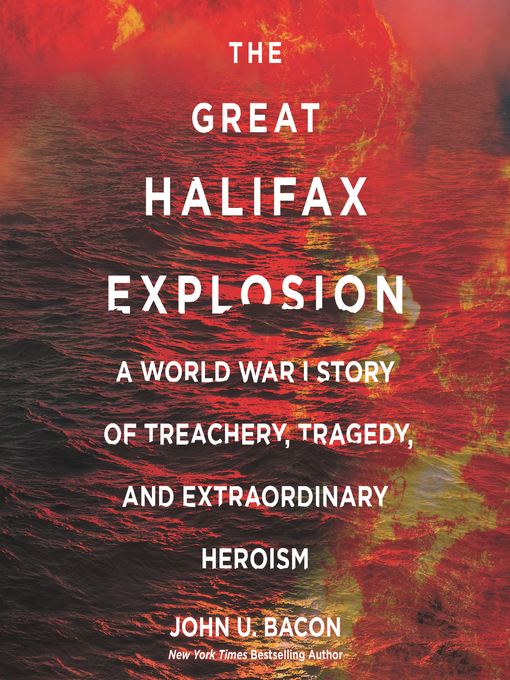
The Great Halifax Explosion
A World War I Story of Treachery, Tragedy, and Extraordinary Heroism
کتاب های مرتبط
- اطلاعات
- نقد و بررسی
- دیدگاه کاربران
نقد و بررسی

The centennial of the shocking event this book discusses takes place in December 2017. The timing is perfect for an in-depth study of the causes and consequences of the largest man-made explosion on earth before the atom bomb was dropped on Hiroshima. Sadly, listeners may become exhausted by Johnny Heller's selection of an urgent newscaster tone to deliver the many chapters preceding the event itself. With the author making deep dives into the personal histories of a variety of individuals affected by the explosion--including backstories from the battlefields of the Great War--this kind of unrelenting voicing numbs the ears before the tragedy even occurs. Mispronunciations of local place names also intrude on listening interest. Heller chooses more nuanced tones throughout the drama itself and its aftermath. F.M.R.G. � AudioFile 2017, Portland, Maine

June 15, 2017
In December 1917, the French freighter Mont-Blanc left New York for war-exhausted Europe with fresh troops and an unprecedented 3,000 tons of explosives, then was struck by the relief ship Imo in Halifax Harbor, Nova Scotia. The resulting explosion, which leveled 2.5 square miles of Halifax, killed 2,000 people, and wounded 9,000 more, was the largest explosion humankind managed before the atomic bomb. From the author of three New York Times best sellers, interestingly in the area of sports.
Copyright 2017 Library Journal, LLC Used with permission.

November 15, 2017
Halifax, Nova Scotia, in 1917, was a major stopping place and reshipment point for war supplies shipped to Europe. Thousands of ships carrying war material passed safely through the harbor on their way to France and Great Britain. On December 6, 1917, two cargo ships collided in the narrow channel that connects the harbor basin to the Atlantic. One ship, the Mont-Blanc, was heavily laden with aviation fuel, picric acid (a high explosive), guncotton, and dynamite. The result was the largest explosion in history, until that time, which devastated Halifax and much of the port infrastructure. Some 2,000 Haligonians died and 9,000 were wounded. Bacon (Three and Out; Endzone) treads familiar territory, as there are several books on the subject, but his respectable narrative, drawn from well-documented stories, details the lapses in procedure and judgment that led up to the catastrophe, describing both the victims' accounts and the enormous outpouring of aid from both Canada and America. VERDICT An accessible narrative useful to all World War I collections in which the event is not otherwise covered.--Edwin Burgess, Kansas City, KS
Copyright 2017 Library Journal, LLC Used with permission.

October 1, 2017
A history of the destruction of a Canadian city by an explosion as powerful as a nuclear weapon.In 1917, the thriving seaport of Halifax, Nova Scotia, was leveled by a munitions explosion of unprecedented force when two ships collided in the city's harbor. One carried 2,925 tons of high explosives; 494 steel drums of combustible airplane fuel; 250 tons of TNT, and 2,366 tons of the unstable, poisonous chemical picric acid, even more powerful than TNT. The ship was bound for France via Halifax as part of a convoy, the better to avoid German U-boats, until miscalculations ended in a devastating "awkward, dangerous dance." Synthesizing locally published sources, a family archive, and World War I histories, Bacon (Endzone: The Rise, Fall, and Return of Michigan Football, 2015, etc.) documents the terrifying incident in vivid detail: events leading up to the ships' arrival; a capsule history of Halifax and a reprise of the start of World War I; the nail-biting collision; and its gruesome, horrific aftermath. Fires blazed, fueled not only by the explosives, but by overturned stoves and furnaces in homes; shock waves blasted out windows, spewing glass; railroad tracks were thrown up, factories crushed, wooden houses reduced to kindling. A tsunami, created by the air waves, quickly followed. Many who survived the conflagration were caught in the undertow and drowned. The explosion, Bacon writes, "destroyed 6,000 buildings, rendering 25,000 people--almost half the population of Halifax--homeless in one-ear-splitting whoosh" and killed 1,600 instantly. Corpses, many dismembered or burned beyond recognition, were scattered everywhere. Survivors at first assumed that the city had been attacked by Germans; years later, trials revealed the culpability of the ships' captains. When word spread--by telegram--to other Canadian cities and to Nova Scotia's American neighbors, help was immediate and generous. Boston, especially well-prepared because of the war, sent doctors, nurses, medical supplies, and many millions of dollars in aid. Since 1976, Boston's annual Christmas tree has been a gift of thanks from Halifax.An absorbing history of disaster and survival.
COPYRIGHT(2017) Kirkus Reviews, ALL RIGHTS RESERVED.

























دیدگاه کاربران